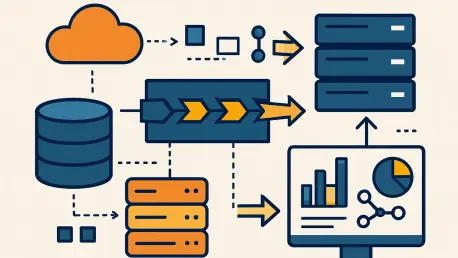I’m thrilled to sit down with Chloe Maraina, a renowned Business Intelligence expert whose passion for big data and data science has transformed the way organizations visualize and leverage their information. With a keen eye for creating compelling visual stories, Chloe has dedicated her career to shaping the future of data management and integration. In this interview, we dive into the evolving world of Data Architecture, exploring its critical role in aligning business strategies with technical solutions, the essential components that drive data-driven decisions, and the innovative patterns shaping modern data systems. Join us as Chloe shares her insights on how robust Data Architecture can empower organizations to manage risks, enhance insights, and adapt to rapid technological changes.
How would you describe Data Architecture in simple terms, and why does it matter to organizations today?
Data Architecture, at its core, is the blueprint that defines how data is collected, stored, processed, and used within an organization. Think of it as the foundation of a house—it’s what holds everything together, ensuring data flows smoothly from production to consumption. It matters because, in today’s world, data is a key asset. Without a solid architecture, companies struggle to make sense of their information, leading to wasted time, missed opportunities, and even risks like security breaches. A well-designed Data Architecture helps organizations turn raw data into actionable insights, aligning their business goals with technical capabilities.
In what ways does Data Architecture serve as a bridge between a company’s business strategy and its technical execution?
Data Architecture acts as the translator between high-level business goals and the nitty-gritty of technical systems. On one side, you have business leaders who want insights to drive decisions—say, understanding customer behavior to boost sales. On the other, you have IT teams managing databases, cloud systems, and data flows. Data Architecture creates a framework where these two worlds meet. It ensures the data systems are built to support strategic goals, like providing real-time analytics for faster decision-making, while also making sure the technical setup is scalable and secure. Without this bridge, there’s a disconnect—business needs aren’t met, and tech investments don’t deliver value.
Can you walk us through the key components of Data Architecture and how they contribute to data-driven decision-making?
Absolutely. Data Architecture can be broken down into three main components: outcomes, activities, and behaviors. Outcomes are the tangible pieces, like enterprise data models and automated data flows, which provide a clear picture of how data is structured and moves through the organization. Activities are the actions we take, such as migrating to the cloud or building data pipelines, to ensure data is accessible and usable. Behaviors are the human element—mindsets like focusing on Data Quality or fostering Data Governance collaborations that ensure data is reliable and well-managed. Together, these components create an environment where data is not just stored but transformed into insights, enabling smarter, faster decisions across the board.
How has the push for modernization, especially with streaming data and new technologies, influenced the evolution of Data Architecture?
The demand for real-time insights from streaming data has been a game-changer. A few years ago, batch processing was the norm—data was collected and analyzed after the fact. Now, with streaming data from IoT devices, social media, and transactions, businesses want insights instantly to stay competitive. This has pushed Data Architecture to evolve rapidly. We’re seeing more cloud migrations because they offer scalability for handling massive data volumes. New formats and tools, like containerized applications, speed up deployment and integration. The architecture must now be flexible enough to ingest varied data types at high speeds while maintaining security and governance. It’s a constant balancing act, but it’s exciting to see how it drives innovation.
What are some of the emerging Data Architecture patterns, and how do they address the needs of modern businesses?
Modern businesses are adopting several innovative patterns to handle their complex data needs. Take the data lakehouse, for example—it blends the structured storage of a data warehouse with the flexibility of a data lake, allowing companies to manage both structured and unstructured data in one system. Then there’s data mesh, which decentralizes data ownership across different domains, fostering collaboration in large organizations. Data fabric is another fascinating pattern—it uses automation to unify data across disparate systems, making integration seamless. These patterns address key needs like scalability, flexibility, and accessibility, ensuring businesses can adapt to growth and leverage data from multiple sources without getting bogged down by silos.
How does a strong focus on Data Quality and Governance shape the effectiveness of Data Architecture?
Data Quality and Governance are the backbone of effective Data Architecture. If the data going into your systems is inaccurate or inconsistent, no amount of fancy tech will save you—your insights will be flawed. A Data Quality mindset means prioritizing clean, reliable data from the start, which directly improves the models and schemas in your architecture. Governance, on the other hand, sets the rules for how data is accessed, used, and protected. It creates a clear map of data ownership and responsibilities, reducing risks like unauthorized access. Together, they ensure the architecture isn’t just a structure but a trusted system that delivers accurate, actionable results while keeping data secure.
What role do you see emerging technologies like cloud migration and data pipelines playing in the future of Data Architecture?
Cloud migration and data pipelines are pivotal in shaping the future of Data Architecture. The cloud offers unparalleled scalability and cost-efficiency, allowing organizations to offload heavy lifting like storage and security to providers while focusing on deriving insights. It’s a no-brainer for handling the growing volume and speed of data. Data pipelines, meanwhile, are like the highways of data movement—they streamline how data is transformed and shared across systems, cutting down latency and improving integration. As businesses continue to prioritize real-time analytics and cross-team collaboration, these technologies will become even more central, enabling architectures that are agile and responsive to change.
What is your forecast for the future of Data Architecture, especially with trends like AI and machine learning on the rise?
I’m incredibly optimistic about the future of Data Architecture, especially with AI and machine learning gaining traction. These technologies rely heavily on high-quality, well-structured data, so Data Architecture will become even more critical. I foresee architectures becoming more automated—think AI-driven data integration and self-healing systems that detect and fix data issues in real time. We’ll also see tighter integration with generative AI, where architectures support not just analysis but creation, like generating predictive models or personalized customer experiences. The challenge will be balancing innovation with governance, ensuring data remains secure and ethical. Overall, I believe Data Architecture will evolve into a dynamic, intelligent framework that powers the next wave of digital transformation.









